 Gunman goes to club to murder mob boss but changes mind and shoots terrible singer instead. 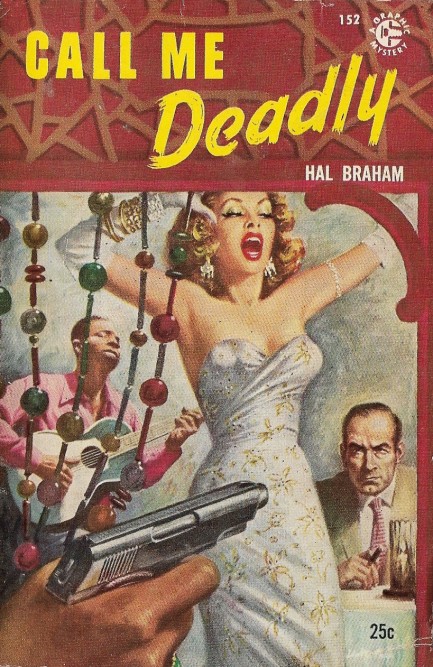
Sometimes you win with these obscure old novels, and sometimes you lose. Since there's so little info on many of them, for us the most important reason whether to buy one is its price. We often pay more for ones we really want, but if it's cheap and the cover art is interesting, we pull the trigger. Hal Braham's 1957's mystery Call Me Deadly was eight dollars, which is a nice bracket, and as a bonus it has an excellent cover by Walter Popp. His dramatic nightclub tableau doesn't correspond to any scene in the story, but purely as an illustration we love it.
What we don't love is that, literarily, there's nothing special here. Ex-cop and recent widow Jim Dillon has been off the L.A. beat for two years and is now an insurance investigator with American Reporting Service. He's ordered to look into the death of a man named John Jasnich who had a large double-indemnity policy with a company—National Casualty—that doubts their client really went over the rail of a ferry into the Pacific Ocean to drown. His corpse hasn't turned up, and as you'll start to suspect early on in the proceedings, it never will.
Close calls with vicious thugs, interludes with three women of very different types, and hard-boiled repartee with various police ex-colleagues and current insurance industry competitors bring Dillon, long and windingly, to a twist ending that pushes into similar territory Chinatown would use seventeen years later. Despite that, the appropriate word for Braham's work here is, we think, perfunctory. There's plenty of mystery, but far less plot impetus than we'd have liked. He published seven other books under his name and the pseudonym Mel Colton, but Call Me Deadly had nothing to encourage us to buy again. Unless it's eight dollars or less.
 That's right, I'm looking at you. Read this magazine and learn how to be a real man. 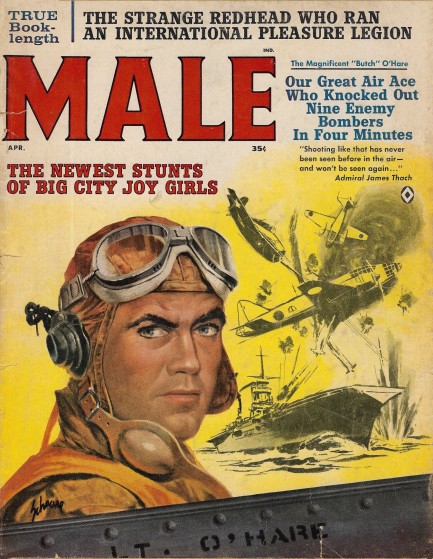
It seems to us that the purpose of men's adventure magazines was to teach ordinary schlubs a little something about how to keep it real, and this issue of Male published in April 1962 fulfills the mandate. Behind the steely-eyed cover art by Harry Schaare, and mixed between interior art by Charles Copeland, Rafael de Soto, James Bama, and Walter Popp, readers learn how to navigate big city vice, survive a nuclear attack, avoid appliance repair scams, pick the perfect car to cruise the open road, and—most importantly—get a raise at their soulsucking office jobs. Those are all fine offerings, but we particularly like the story, “Let's Let the Russians Beat Us to the Moon,” which suggests that if the Russians are so eager to get to the moon let them serve as sacrificial lambs—since the place is filled unknown dangers. Journalist and skeptic Ray Lunt reasons, “For all our scientists know, the moon may be 10,000 miles from where we think it is, paved with quicksand 90 feet deep, and full of brain gas instead of air.” Instead of air? Sounds like he was the one inhaling brain gas. We checked out the story just to find out what brain gas was, and learned basically nothing. He mentions that some scientists—unnamed of course—believe the moon might harbor poisonous gas, but the brain thing never comes up. What a tease. He does, though, run through a long list of other moon horrors fit for a Heinlein novel. He must have been really bummed in 1969 when it turned out to be just a big, dusty rock. We have scans below, and more Male in the website. Feel free to click the keywords. 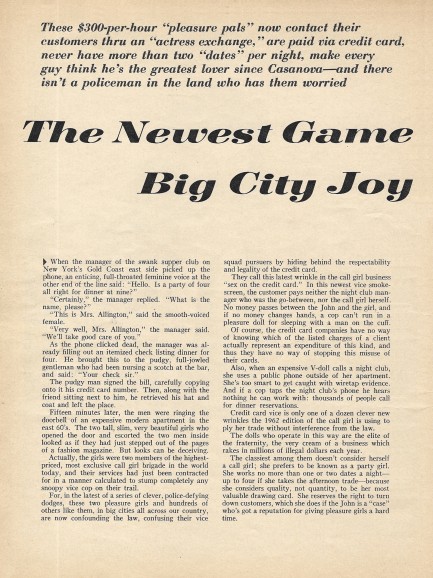 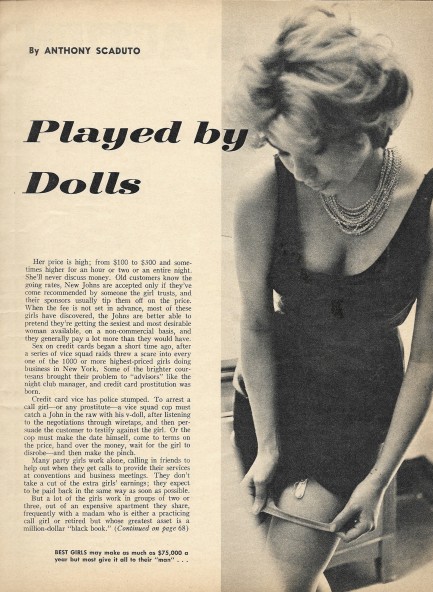 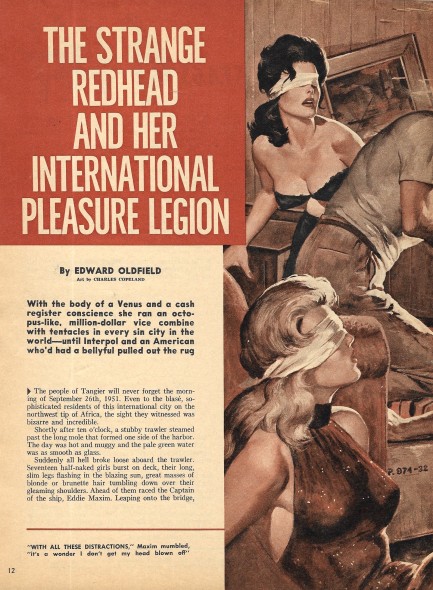 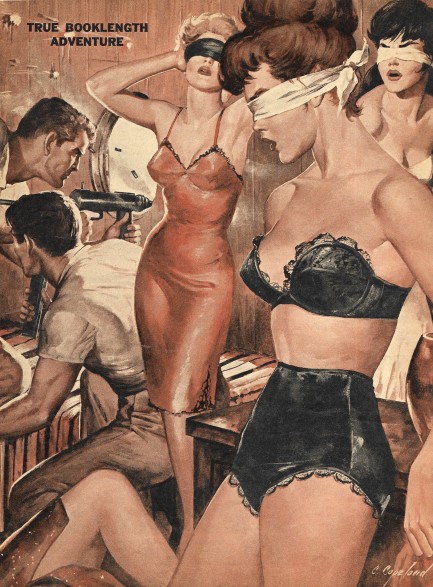 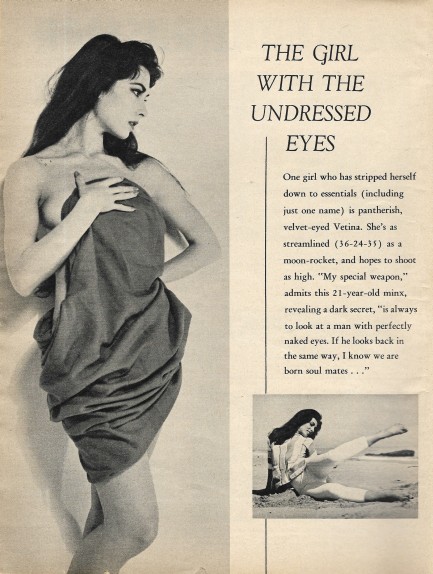   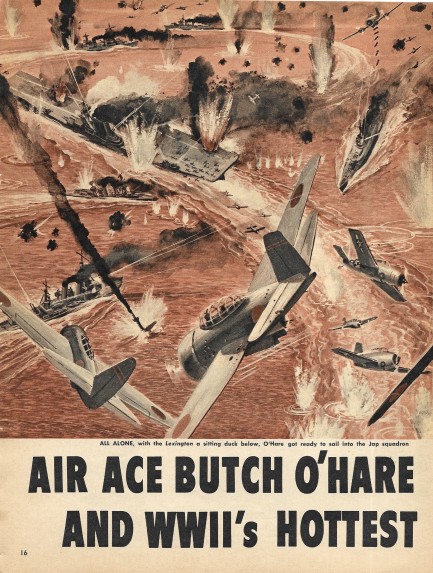 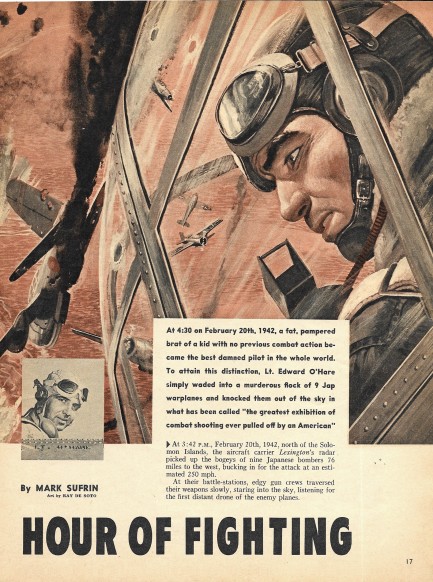 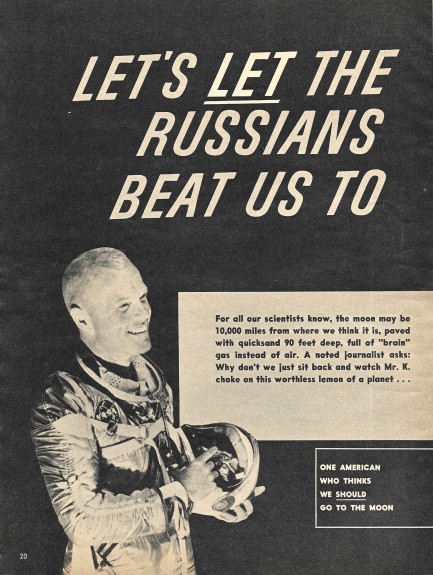 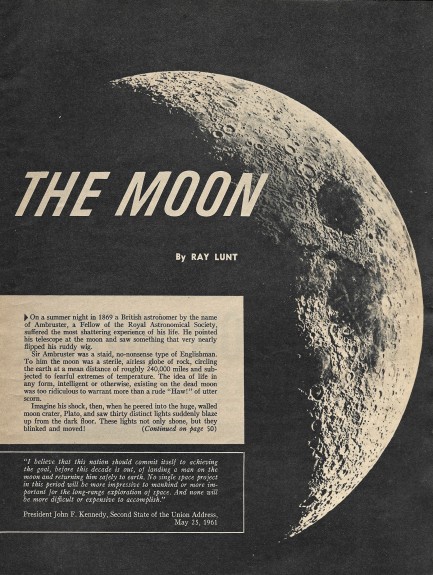 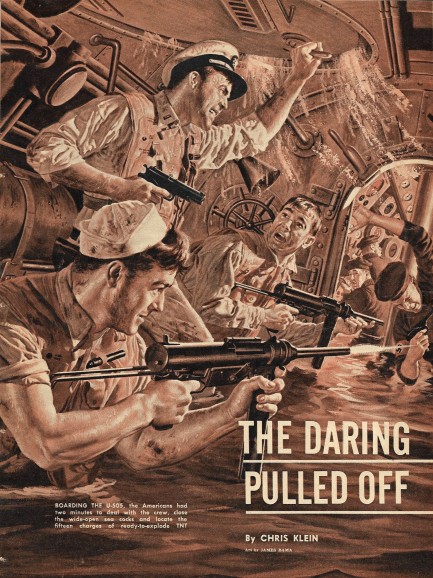 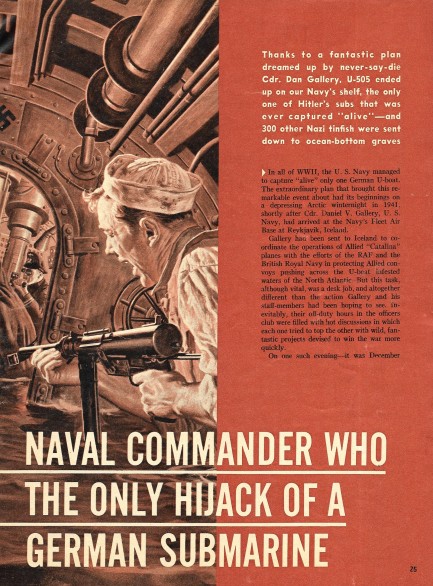 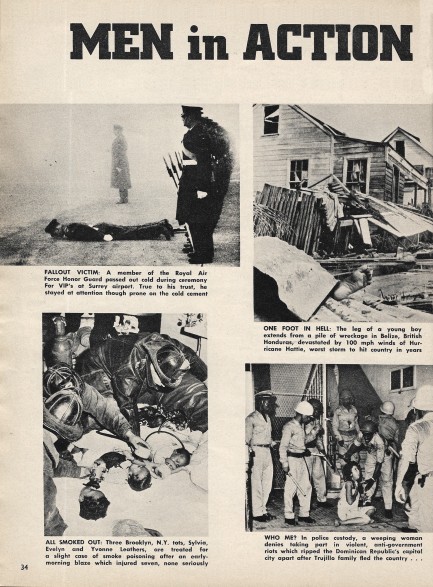 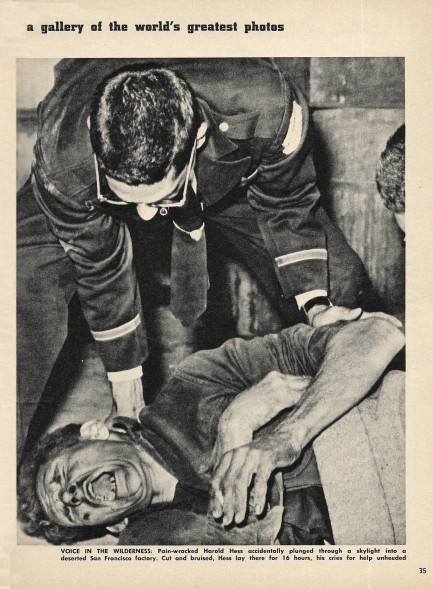 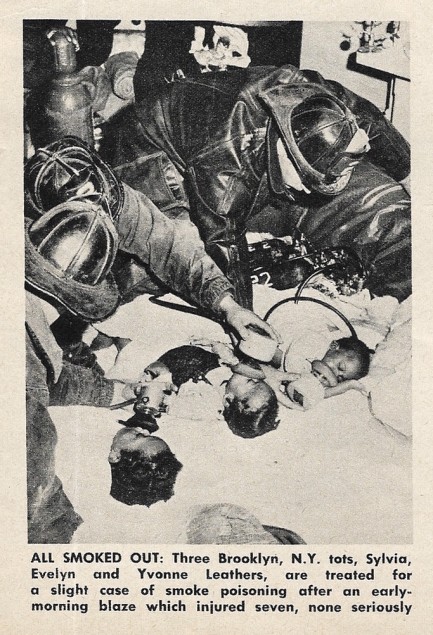  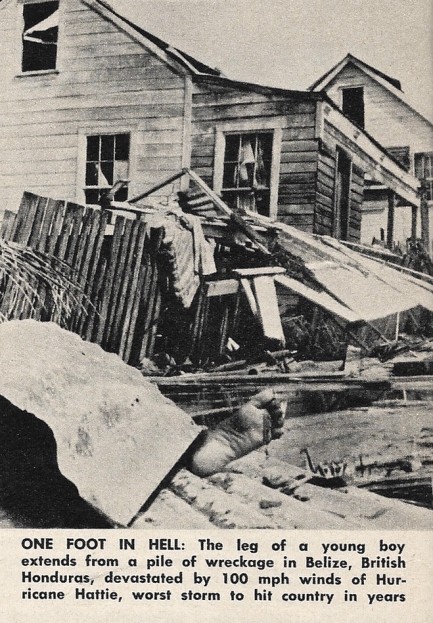 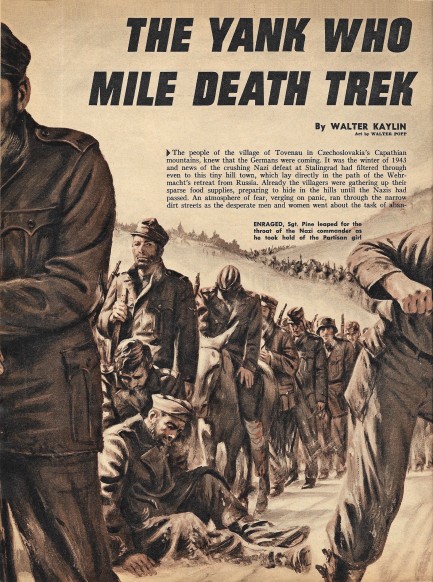 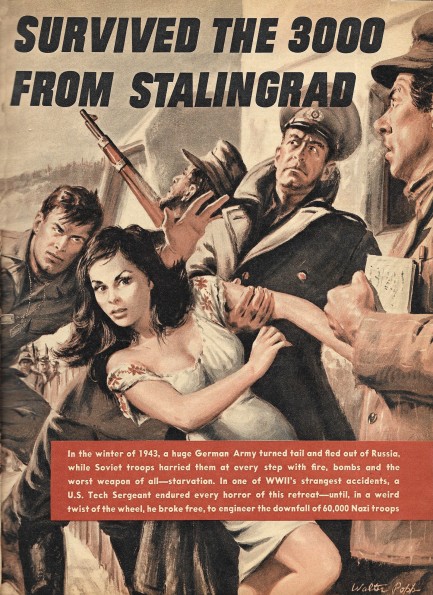 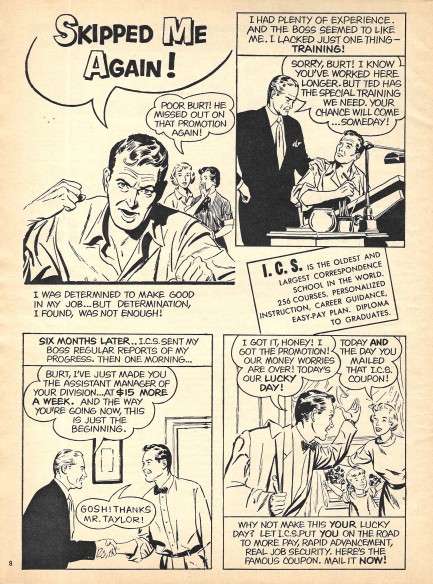 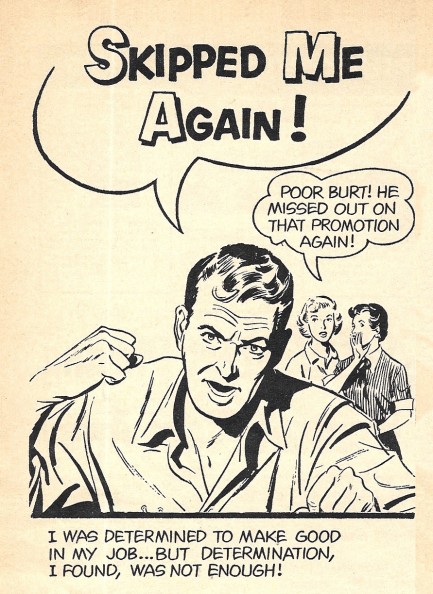 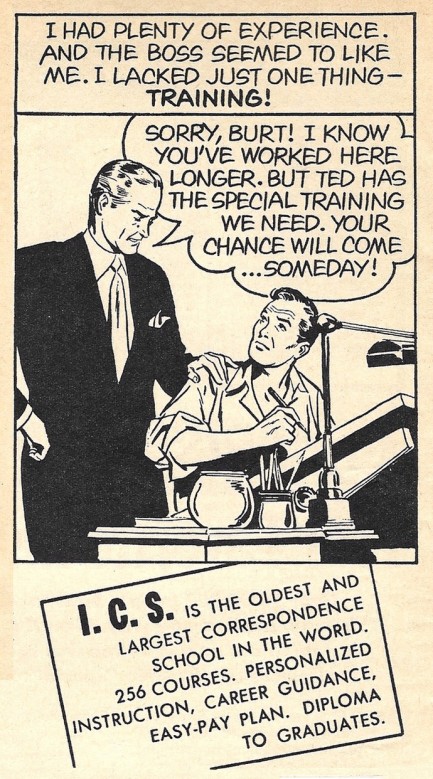 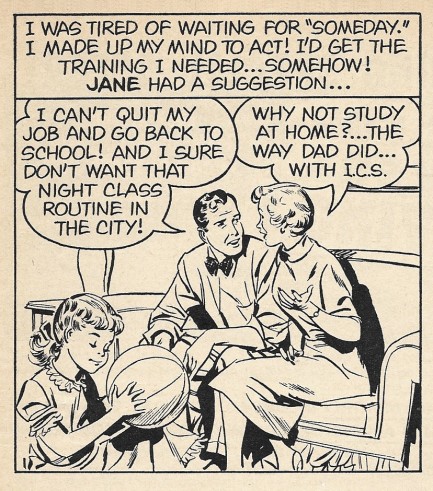 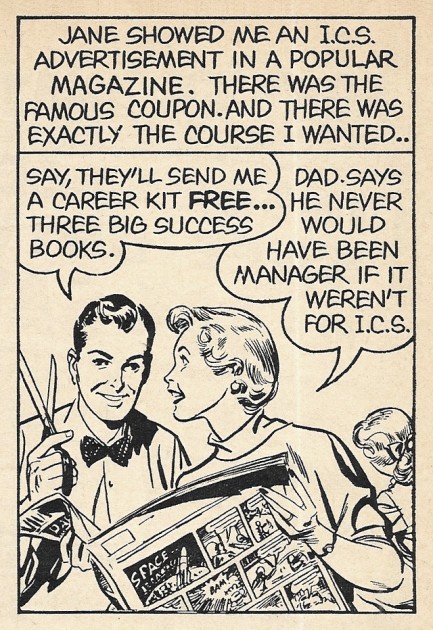 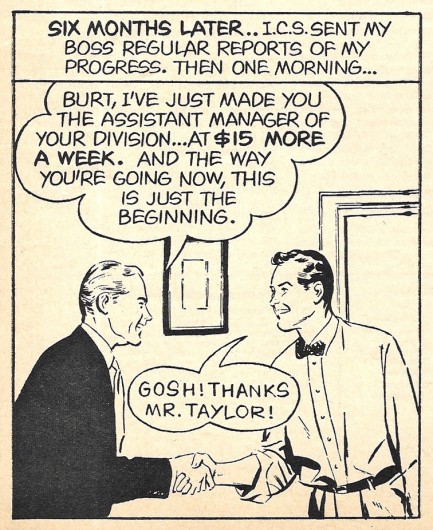 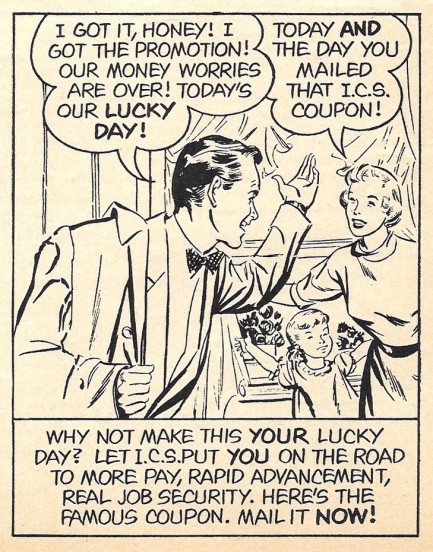
 Headquarters, my gas mask has failed! I'm throwing a grenade! How the hell does this thing work? Over! 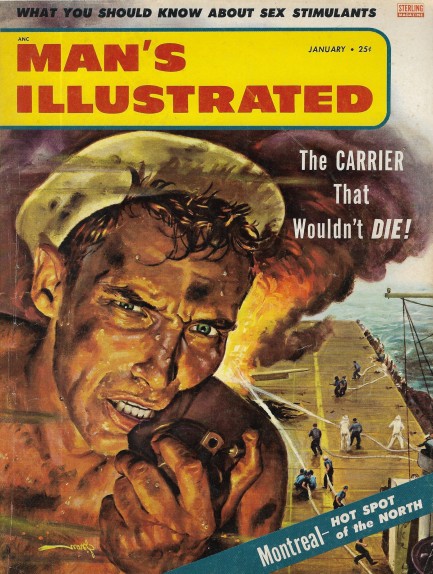
George Gross art fronts this January 1956 issue of Hanro Corp's bi-monthy magazine Man's Illustrated. It's an interesting image, but here's where we show our age, or lack of industrial background, or something, because we have no idea what the hell Mr. Flinty Eyes on the cover is holding. Hand grenade? Gas mask? Some kind of steampunk style microphone? Combo of all three? Well, not knowing is not a problem. We still like the image.
It's been a while since we featured this magazine, but we're glad to get back to it because inside this issue there's art from Walter Popp and Rudolph Belarski, and a nice feature on Rear Window actress Georgine Darcy, who we've talked about once or twice before. As far as written content, you get plenty of war and hunting action, of course, but we were drawn to, “The Hottest Town North of the Border,” an investigative piece by journo B.W. Von Block. What town is he talking about? Montreal, which apparently back in ’56 was the one of the best places in the world to get your ashes hauled.
These type of stories, which were standard in old men's magazines, always give us a laugh because with their breathless focus on subjects like legal prostitution, nude beaches, and dusk-to-dawn nightclubs they show how repressed the U.S. was compared to so much of the world. It still is, actually. Trust us, we've been around, lived abroad for a long time now, and greatly enjoyed the more permissive societies in which we've resided—including our current one.
The U.S. does have many good points, though, one of which is that no country's inhabitants preserve its popular media so prodigiously—which is why we have so many vintage books and magazines to share on Pulp Intl. in the first place. We've pondered many times why Americans hoard more than other cultures and we've finally come up with an answer: garages. Two thirds of Americans have garages. So here's to American garages. They give millions the joy of being their own museum curators.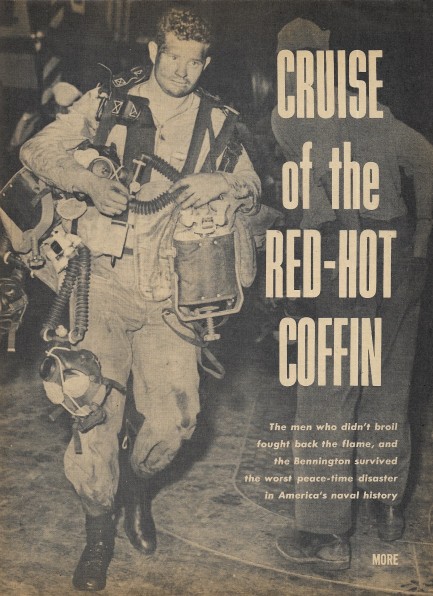 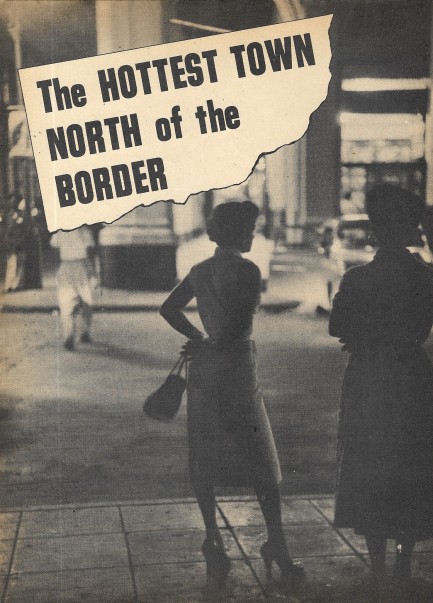 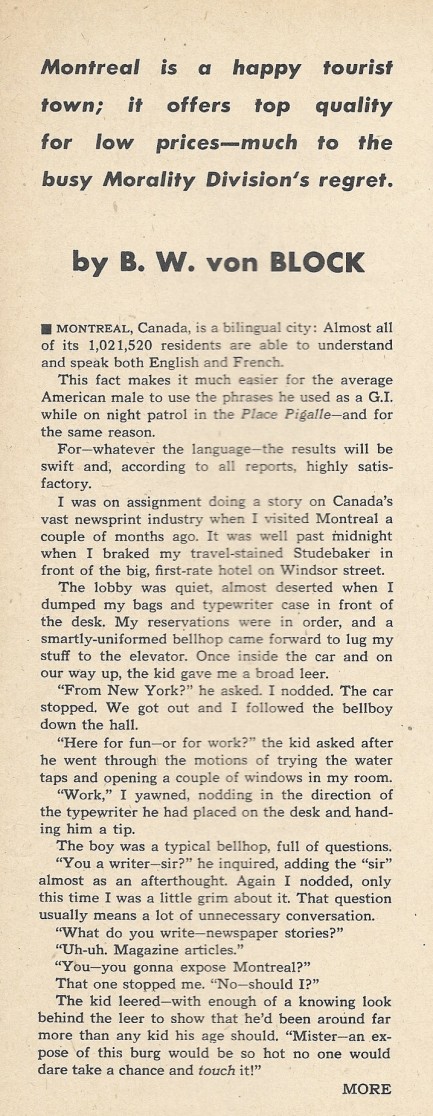 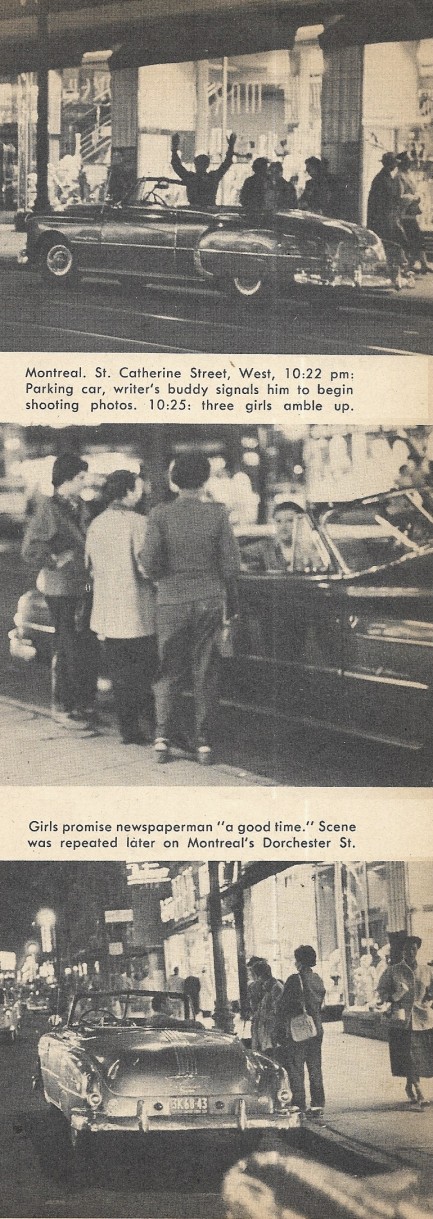 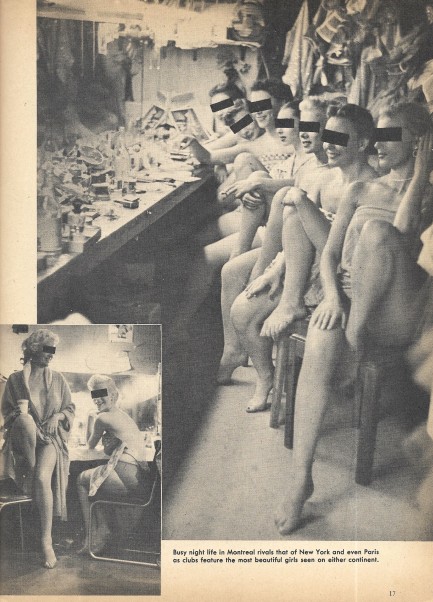 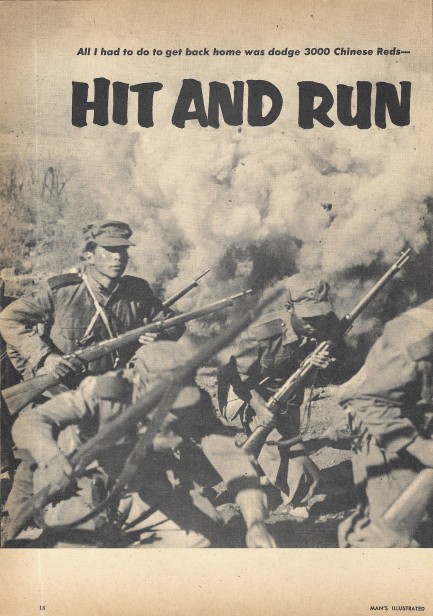 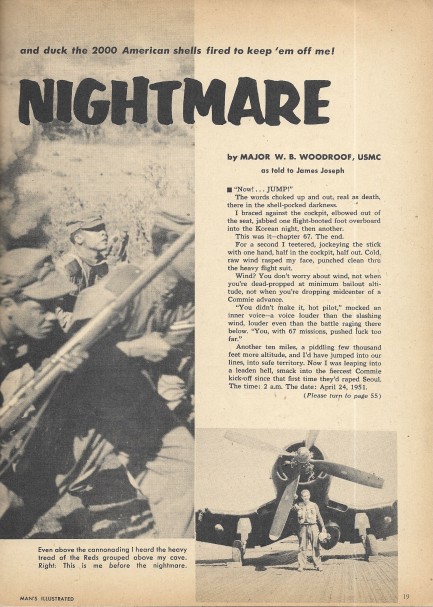 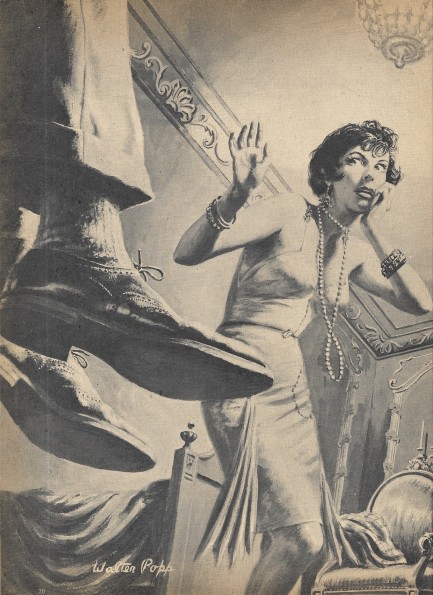 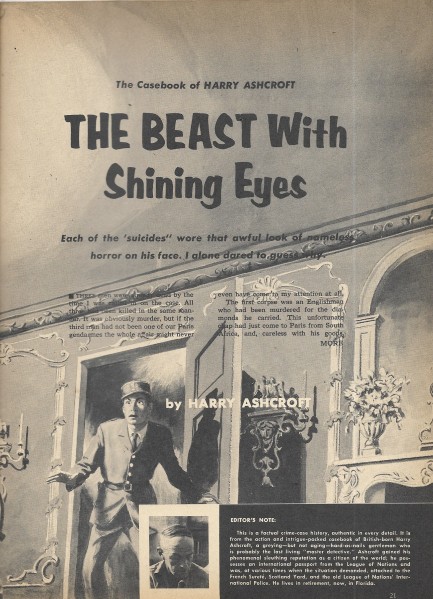 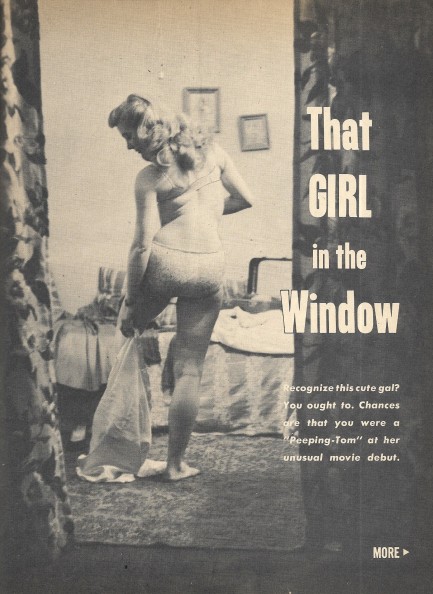 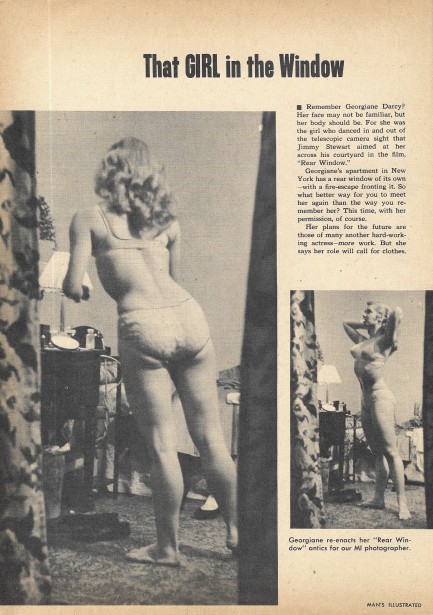 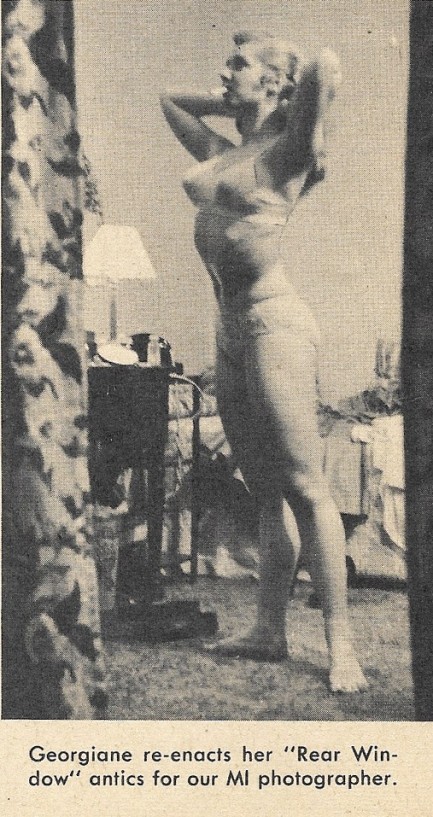 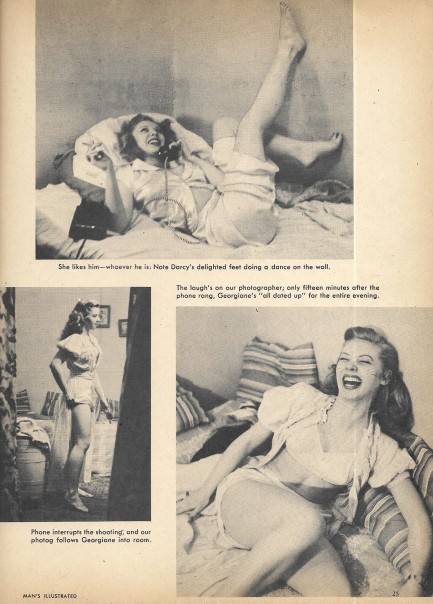 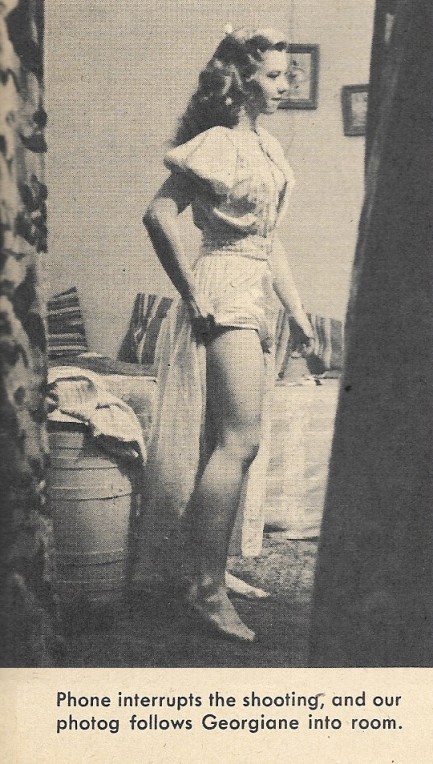 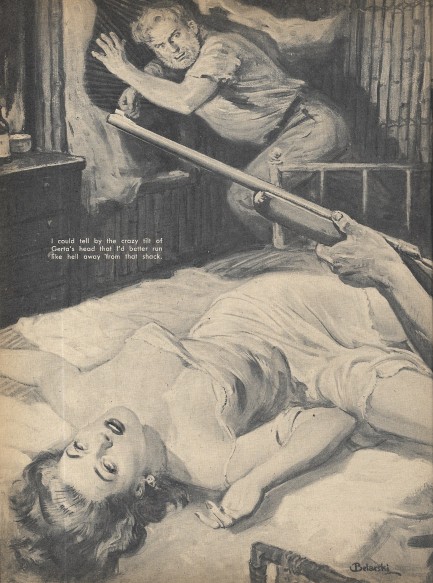 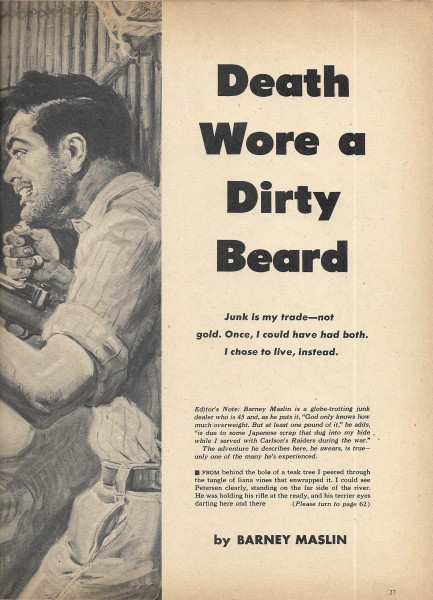 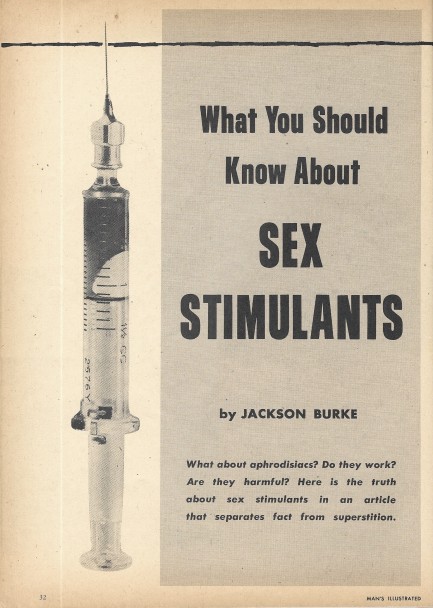 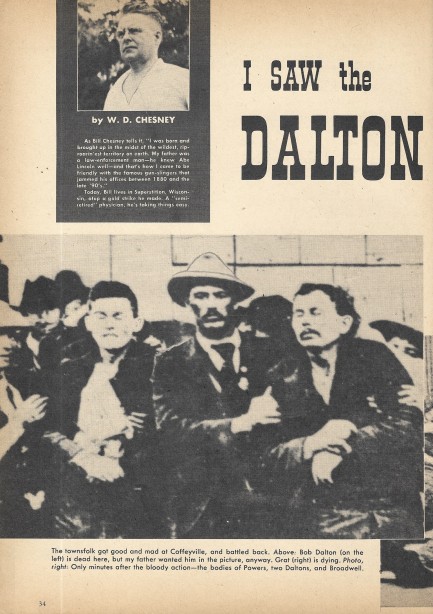 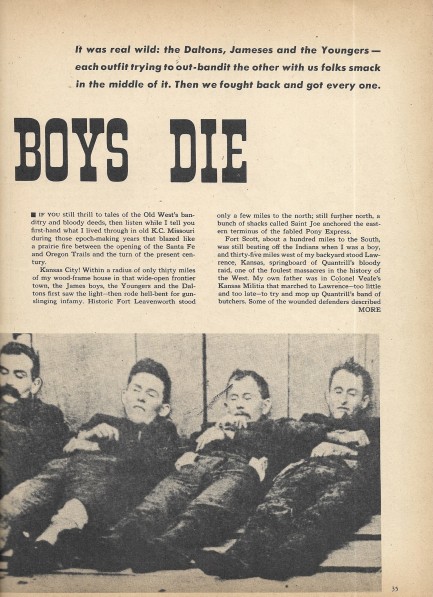 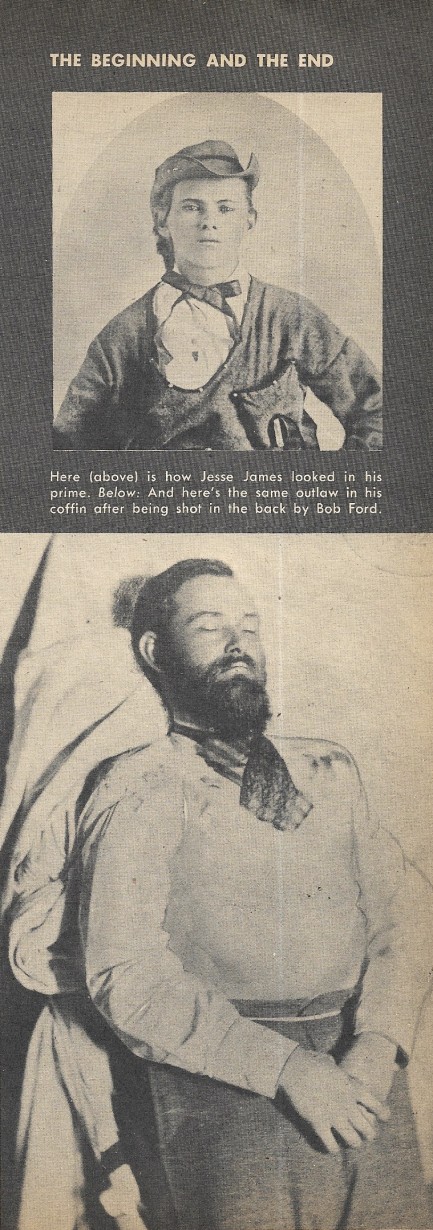 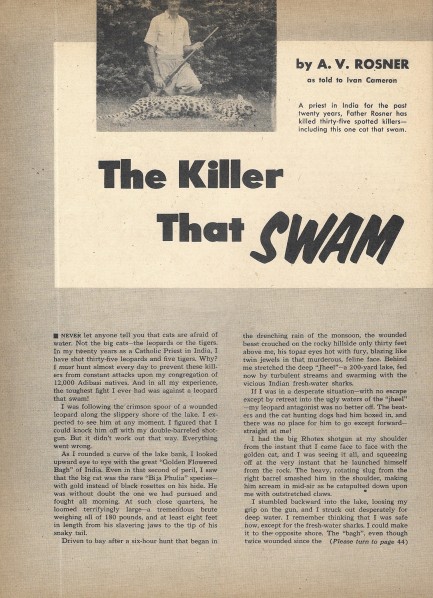 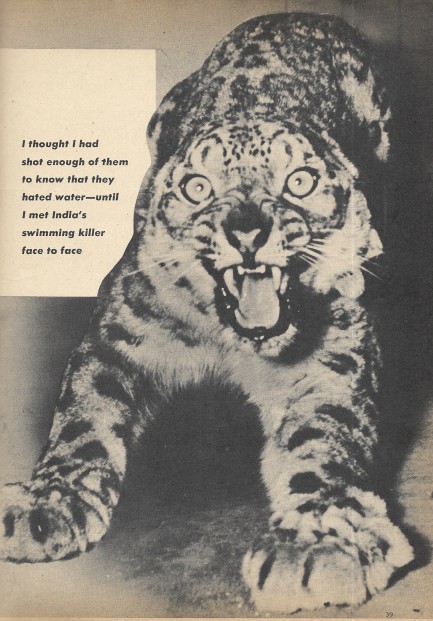 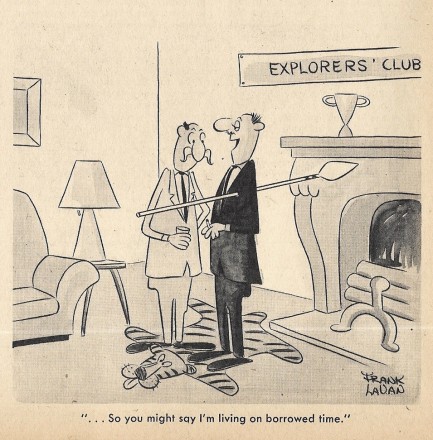
 First let me show you these, then I'll explain about your mean-ass cat, and that shovel in the yard. 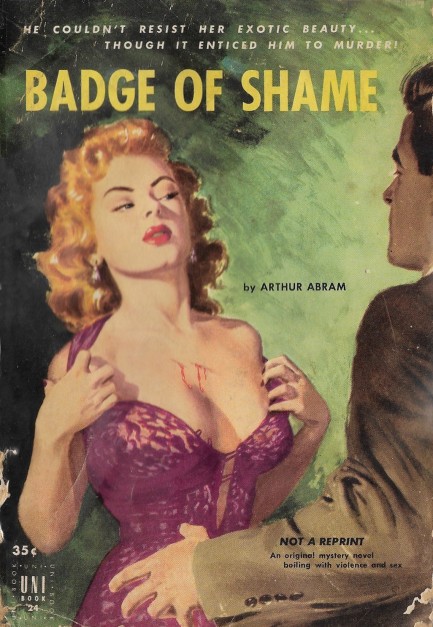
We would often see Arthur Abram's 1952 thriller Badge of Shame online and for years wondered what the story was with the cover art. We learned it was painted by Walter Popp, but what exactly was he depicting with this bleeding woman exposing her injury? Well, we bought a copy and the mystery is revealed early. It has nothing to do with a mean cat. The woman here was deliberately cut by a sadistic thief during the theft of her $10,000 brooch. She hires the protagonist, tough guy Shep Duncan, to retrieve her jewelry, and on the cover she's showing him how she was disfigured by the robber. So plotwise, bad boy steals from nice girl, nice girl finds badder boy to get her property back. Simple, right? Well, not so much.
The story doesn't develop quite as expected. For the majority of the book Duncan wanders through New York City, hunted by both cops and criminals, running, hiding, climbing a bridge, riding a subway to Coney Island, all while looking over his shoulder for unseen pursuers and trying to puzzle out a mystery for which he has no clues. Leaving the lead completely in the dark is deliberate on the part of the author, but it still feels like a misstep. Adding to the book's issues are numerous typos and errors, including a character's name printed in reverse. When the entire hallucinatory adventure ends with the villain explaining the master plot to the tied up hero, it's just a letdown. Badge of Shame has a few thrills but it isn't a book we can recommend.
 Marriage to a savage jungle woman is all fun and games until you get on her bad side. 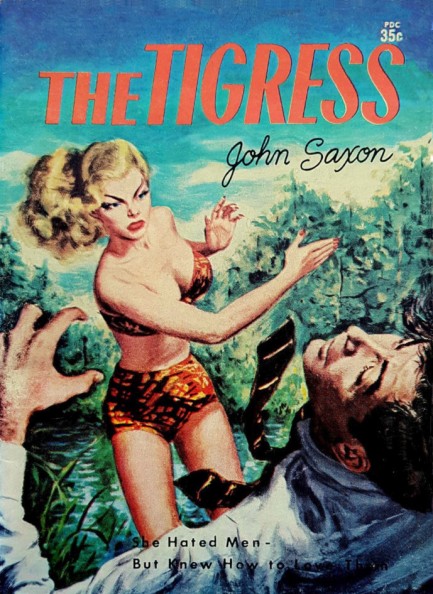
This is a fantastic cover for John Saxon's, aka James N. Gifford's The Tigress, for Novels, Inc, 1952. This poor guy in the art. Takes abuse at the office all day then comes home and has to take more from his wife. Well, it's better than when she ignores him, or worse, perches on the kitchen counter and stares unblinkingly at him for minutes at a time. That's just plain unnerving. But she's worth it, because at her best she's a real pussycat. This cover, sadly, is uncredited. Update: Some online sources now think this art is by Walter Popp. We'll go with that.
 I told you to always stand on a hard 17, and never double down when they deal out death, but you don't listen. 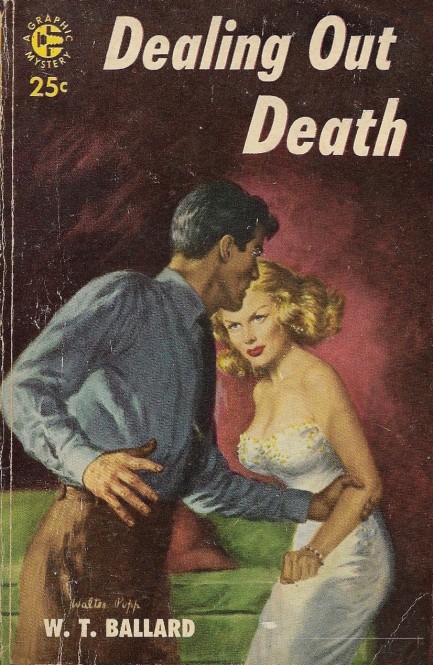
Dealing Out Death is another paperback given to us by a friend. He bought it randomly years ago and passed it along to us when he visited from the States a while back. Of the books he gave us we'd have read this one first if we knew, one, that it had to do with the movie industry (where we once worked), and two, that it was so good. It was written by W.T. Ballard, published by Graphic Books in 1948, and deals with bigtime studio VP Bill Lennox, who tries to figure out who murdered star actress Renée Wilson's husband. Wilson is in Las Vegas to deal with a personal matter—her screw-up brother's desperate plea for money to get out from under a mob boss—but soon discovers that her brother's troubles and her husband's murder are connected to an impending turf war, one initiated by mobsters from the east who want to move in on the legitimate hotel owners. Lennox flies out from Hollywood to find the killer, save his star actress from both danger and bad publicity, and navigate the seething cauldron of Vegas without losing his cool or his life.
In mid-century crime fiction you find tough guys in unlikely places. The various authors, casting about for signature characters, made ass kickers out of insurance adjusters, chemists, charter fishermen, and more. Having known a few movie producers we can tell you they run the gamut. Being a producer generally means you merely have access to money or the ability to raise it, or you have access to a script or treatment and the mandate to shop it. You can get into such a position by working your way up the ladder, but if you come to the party with money already in pocket that buys your entrance. Thus producers in both the old days and today might be former organized crime guys, former drug dealers, and such. Think Chili Palmer in Get Shorty. So the fact that the studio exec hero in Dealing Out Death is so tough is unusual but not unrealistic. Ballard uses the character of Lennox to construct an engrossing plot, imbue it with a strong sense of place, and populate it with numerous competing personalities. He's a very confident writer and he gets the job done in Dealing Out Death briskly and skillfully. The ending is not perfect, but they rarely are. Recommended stuff.
 I've come to kidnap you—for another book cover. 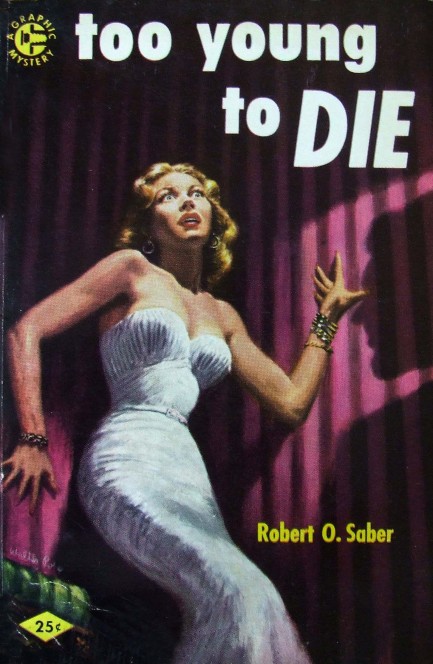 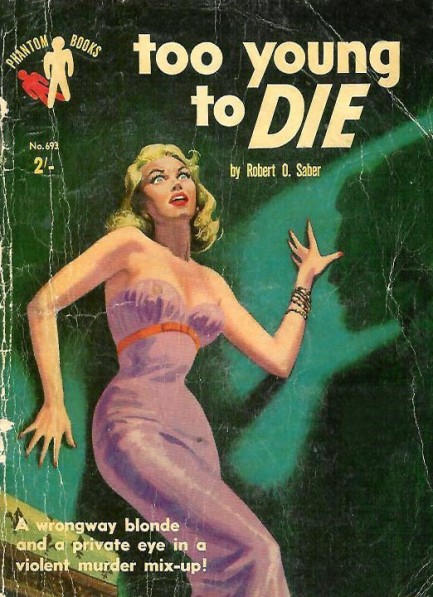
Above you see two covers for Robert O. Saber's thriller Too Young To Die, the first from Graphic Books, and the second from Australian publisher Phantom. The art at top, which we think is brilliant, was painted by Walter Popp, a well known paperback and men's magazine illustrator who we've talked about several times. You can see some of those examples by clicking his keywords at bottom. His cover was copied by an anonymous artist for Phantom's re-issue. So as always we come back to the question: Why were publishers able to copy original art, but not to use it outright? Assume you're Walter Popp and you've already been paid by Graphic for the use of your art. Phantom comes along and asks you to reuse it. It's free money in the sense that you've already done the work, and it's more exposure for your talent. So why not say yes? Since there's no reason in the world to say no we can only assume he was never asked. Looking at it from the other side, if you like Walter Popp's cover work but can't obtain the right to use it, how is it that you can get away with publishing a near exact copy? We posed that question to Bob over at the authoritative website menspulpmags.com, and he said that he thinks copycat covers that were not actual reuses of the original skated under copyright laws, and generally nobody paid much attention to them. Bob also offered these insights: Some of the artists who worked for mid-20th century men's adventure magazines and paperbacks that I've talked to have said they sometimes got paid small reprint fees for reuses of their work, but often did not. In the case of the men's adventure magazines, I know the artists typically only sold first publication rights and the artists who were most business savvy, like Mort Kunstler, made sure to get their originals back from the company or get fees for reuses. But some artists just turned in their illustrations to the art directors and didn't bother to get them back to track whether they were reused. Some magazines that published multiple men's adventure magazines, like those put out by Martin Goodman's Magazine Management company, often reused illustrations in several different issues and sometimes used a magazine illustration on the cover of a paperback published by their paperback subsidiary (Lion Books in the case of Magazine Management), or vice versa. I show an example of a Samson Pollen painting used on a Lion paperback and a Mag Mgt. men's adventure mag in a recent post on my blog here. There are many other examples of men's adventure mag illos being used on both a paperback cover and in a men's adventure magazine. For example, Pyramid published both paperbacks and Man's Magazine and many Pyramid cover paintings showed up as illustrations in Man's. I don't know if artists typically only sold first use rights to paperback publishers or all rights. I suspect it varied with the publisher. I do know many paperback cover paintings were reused both on other paperbacks and in men's adventure mags. I also know that Gil Cohen, who I recently interviewed for my blog, told me he sold only first rights to Pinnacle for the roughly two-hundred Executioner/Mack Bolan paperback cover paintings he did. I'd guess that whether an artist got paid for reuses depended on how honorable the publishers were. Mag Mgt. and Pyramid actually treated their artists pretty well, from what I have been able to glean. However, it seems pretty clear that many low budget men's adventure mags and paperback publishers just ripped artists off by reusing their artwork without paying them. I think that practice was pretty common and there was really no way for artists to keep track of all reuses back then. They would just have to happen to run across them on newsstands. And even then, they might not think it was worth the hassle of trying to do anything about it. Pulp art was basically viewed as "disposable" artwork without a lot of resale value back in the '50s, '60s and '70s. I think most artists were more concerned about getting their next assignment than trying to get smaller reprint fees for past work.
So there you have it, from someone who has spoken to many of the creators from the period. The art was just difficult to keep track of back then. As copies go, Phantom's Walter Popp rip-off is a decent one, though we've seen much better. We have another example of the practice you can check out here. And we're now sure our longstanding suspicions about the usage of celebrity images, which we've discussed several times, fall into the same category. Thanks to Bob for his answers, and we recommend that pulp fans check out his expansive and incredibly informative men's magazine website.
 That's a hell of a knee you got there, baby. If the rest of you's anything like that knee the sky's the limit. 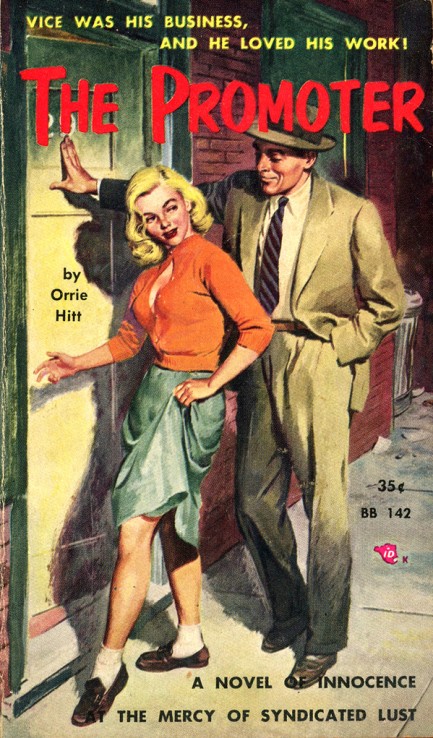
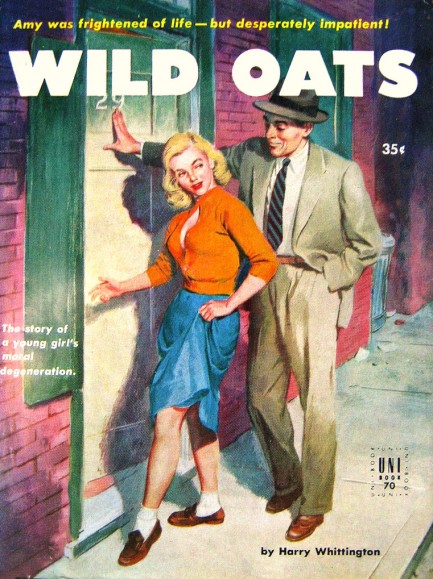 The Promoter, which appeared in 1957 from Beacon Books, is about the dirty picture racket, which is ironic considering how often author Orrie Hitt skirted obscenity laws. When the lead character Bill Morgan, normally a writer for an auto magazine, is recruited by a minister to investigate the big city under-the-counter porn racket he finds himself at first thwarted, then in over his head. He's also supposed to find the minister's missing daughter. Hmm... wonder where she'll turn up? You really get the feeling Hitt is speaking from experience when he describes how the porn industry worked during the mid-1950s, but the book isn't well written. Hitt churned out a novel every couple of weeks, and the haste shows. The best thing we can say is that the scenario is interesting. We know—we aren't exactly promoting sales of the book, but what can we do? At least the cover art is great. It's by the excellent Walter Popp, and had been previously used in 1953 for Harry Whittington's Wild Oats. Click Popp's keywords below for more visual treats. The Promoter, which appeared in 1957 from Beacon Books, is about the dirty picture racket, which is ironic considering how often author Orrie Hitt skirted obscenity laws. When the lead character Bill Morgan, normally a writer for an auto magazine, is recruited by a minister to investigate the big city under-the-counter porn racket he finds himself at first thwarted, then in over his head. He's also supposed to find the minister's missing daughter. Hmm... wonder where she'll turn up? You really get the feeling Hitt is speaking from experience when he describes how the porn industry worked during the mid-1950s, but the book isn't well written. Hitt churned out a novel every couple of weeks, and the haste shows. The best thing we can say is that the scenario is interesting. We know—we aren't exactly promoting sales of the book, but what can we do? At least the cover art is great. It's by the excellent Walter Popp, and had been previously used in 1953 for Harry Whittington's Wild Oats. Click Popp's keywords below for more visual treats.
 Just stay over there a minute. I want you to get the full effect of this awesome pose. 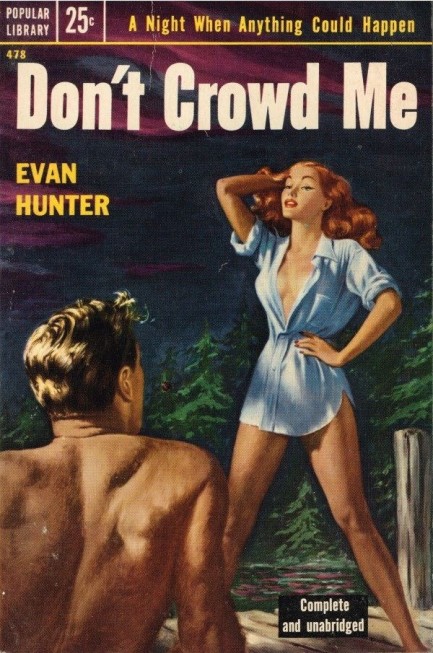
In Evan Hunter's 1954 novel Don't Crowd Me an NYC advertising copywriter seeks tranquility in the lake region but instead finds himself encountering two sisters with very different temperaments who both seem to find him irresistible. Then, of course, there's a murder to spoil everything, and it looks like he's the only one who can solve it. The plot may sound improbable, but Hunter, born Salvatore Albert Lombino, was better known by his pseudonym Ed McBain, which means you would expect this to be decently written. And in fact you would be correct. The cover art, which is great, was painted by Walter Popp.

|
 |

The headlines that mattered yesteryear.
2003—Hope Dies
Film legend Bob Hope dies of pneumonia two months after celebrating his 100th birthday. 1945—Churchill Given the Sack
In spite of admiring Winston Churchill as a great wartime leader, Britons elect
Clement Attlee the nation's new prime minister in a sweeping victory for the Labour Party over the Conservatives. 1952—Evita Peron Dies
Eva Duarte de Peron, aka Evita, wife of the president of the Argentine Republic, dies from cancer at age 33. Evita had brought the working classes into a position of political power never witnessed before, but was hated by the nation's powerful military class. She is lain to rest in Milan, Italy in a secret grave under a nun's name, but is eventually returned to Argentina for reburial beside her husband in 1974. 1943—Mussolini Calls It Quits
Italian dictator Benito Mussolini steps down as head of the armed forces and the government. It soon becomes clear that Il Duce did not relinquish power voluntarily, but was forced to resign after former Fascist colleagues turned against him. He is later installed by Germany as leader of the Italian Social Republic in the north of the country, but is killed by partisans in 1945.
|

|
|

It's easy. We have an uploader that makes it a snap. Use it to submit your art, text, header, and subhead. Your post can be funny, serious, or anything in between, as long as it's vintage pulp. You'll get a byline and experience the fleeting pride of free authorship. We'll edit your post for typos, but the rest is up to you. Click here to give us your best shot.

|
|


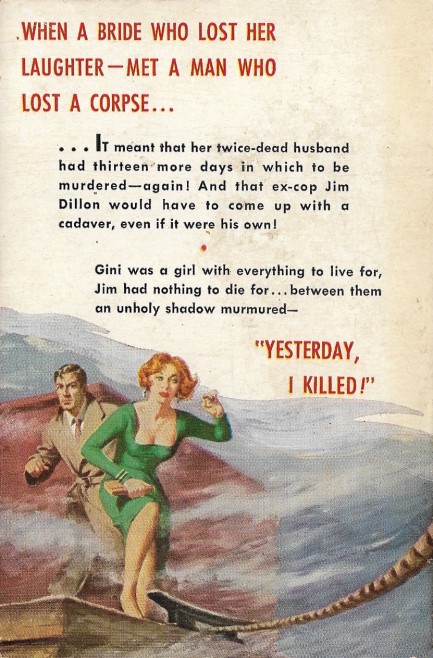





























































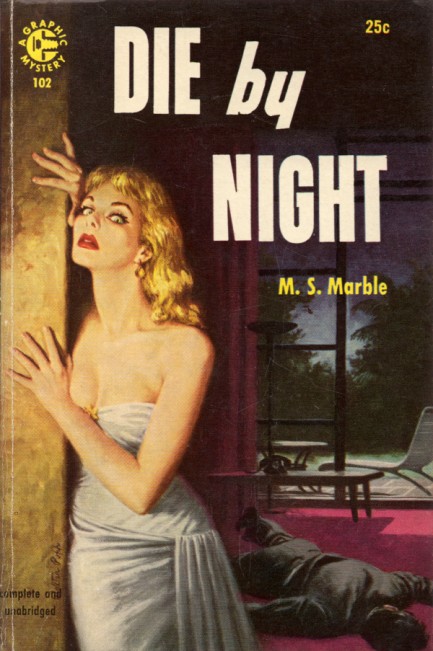
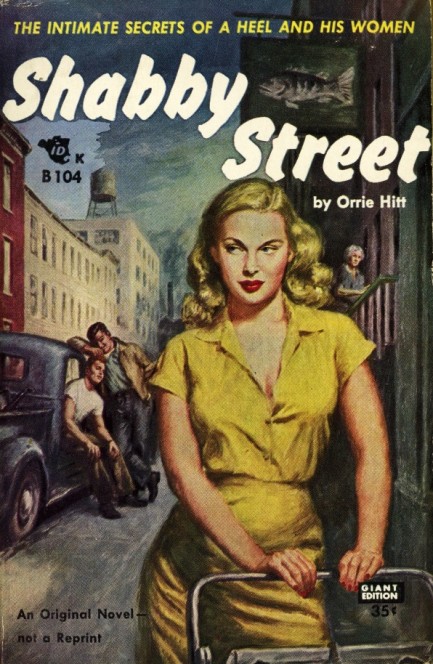
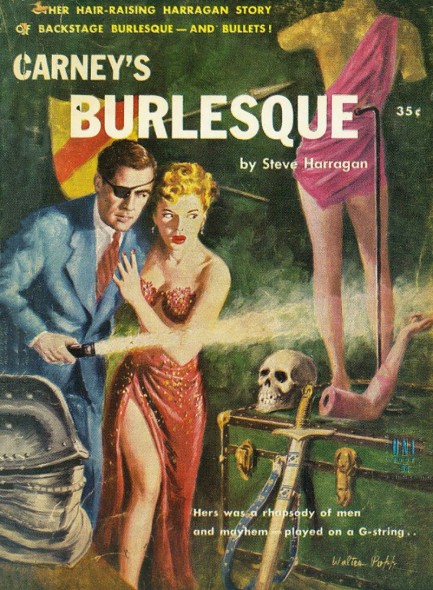
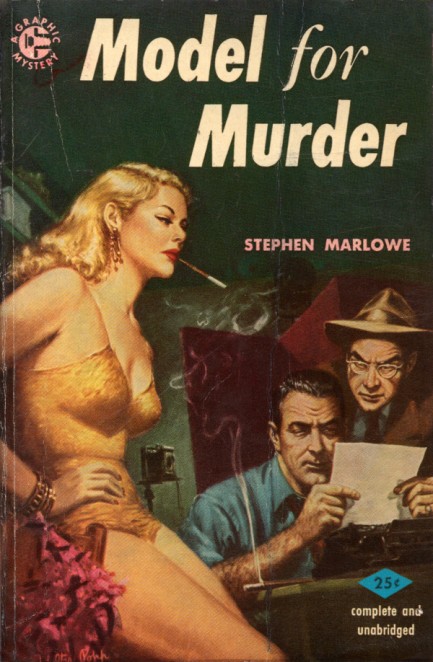
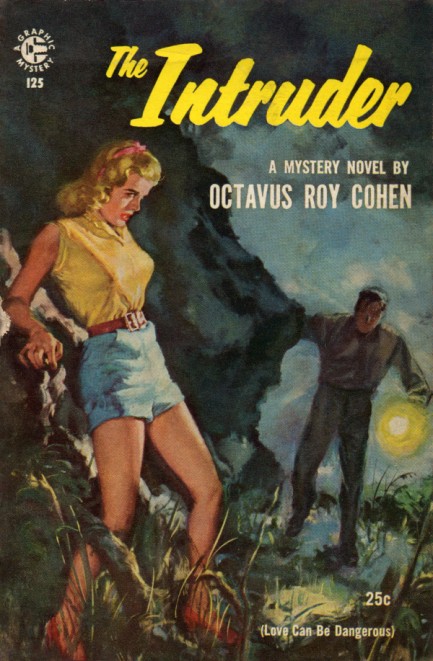
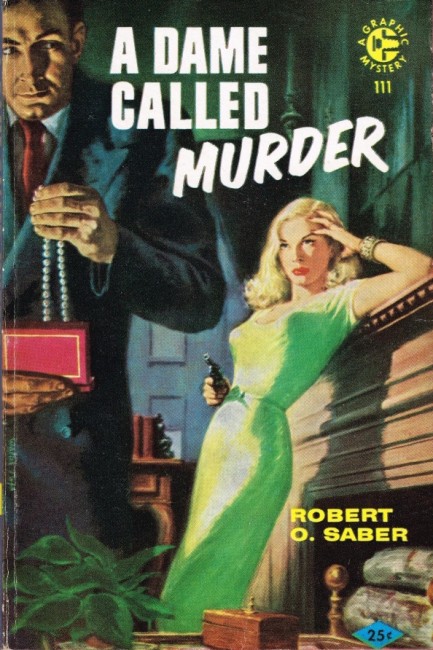
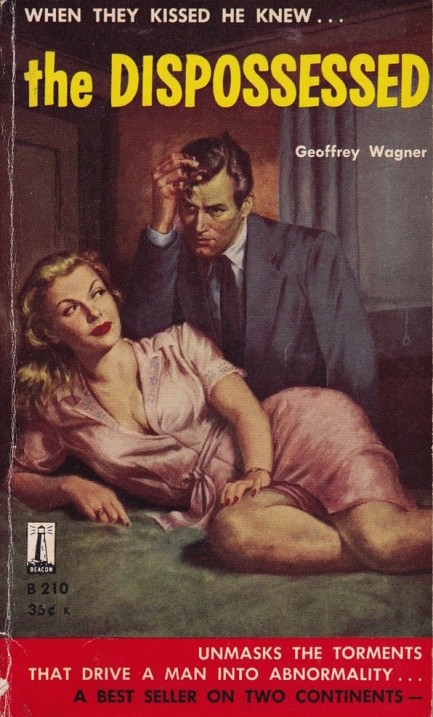
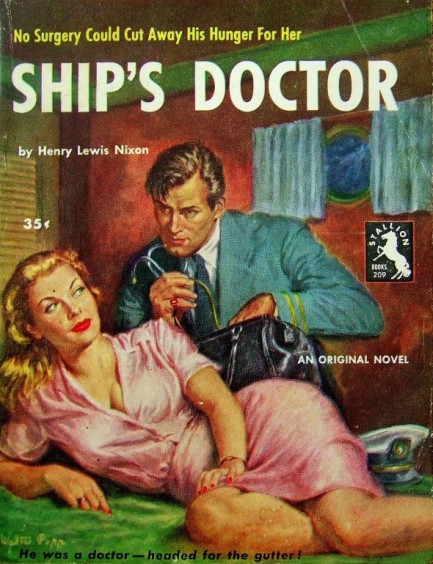
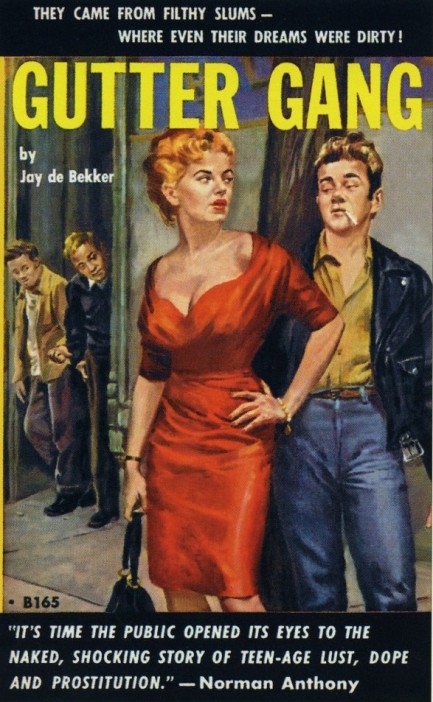
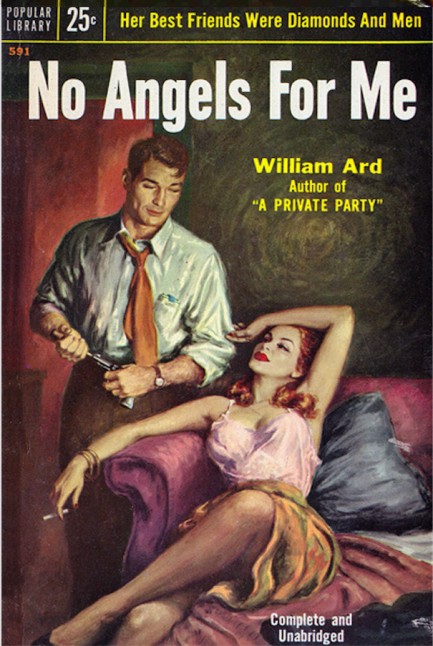
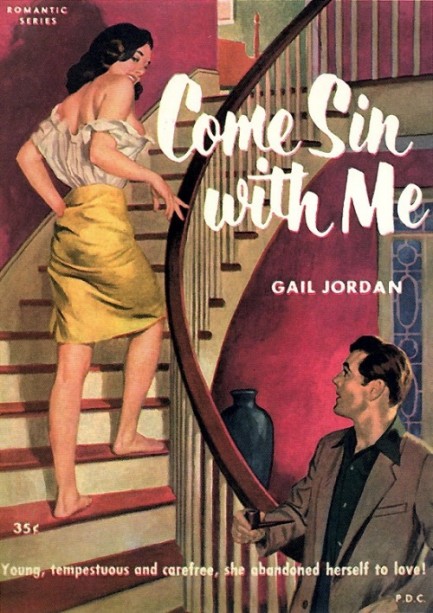





 The Promoter, which appeared in 1957 from Beacon Books, is about the dirty picture racket, which is ironic considering how often author Orrie Hitt skirted obscenity laws. When the lead character Bill Morgan, normally a writer for an auto magazine, is recruited by a minister to investigate the big city under-the-counter porn racket he finds himself at first thwarted, then in over his head. He's also supposed to find the minister's missing daughter. Hmm... wonder where she'll turn up? You really get the feeling Hitt is speaking from experience when he describes how the porn industry worked during the mid-1950s, but the book isn't well written. Hitt churned out a novel every couple of weeks, and the haste shows. The best thing we can say is that the scenario is interesting. We know—we aren't exactly promoting sales of the book, but what can we do? At least the cover art is great. It's by the excellent Walter Popp, and had been previously used in 1953 for Harry Whittington's Wild Oats. Click Popp's keywords below for more visual treats.
The Promoter, which appeared in 1957 from Beacon Books, is about the dirty picture racket, which is ironic considering how often author Orrie Hitt skirted obscenity laws. When the lead character Bill Morgan, normally a writer for an auto magazine, is recruited by a minister to investigate the big city under-the-counter porn racket he finds himself at first thwarted, then in over his head. He's also supposed to find the minister's missing daughter. Hmm... wonder where she'll turn up? You really get the feeling Hitt is speaking from experience when he describes how the porn industry worked during the mid-1950s, but the book isn't well written. Hitt churned out a novel every couple of weeks, and the haste shows. The best thing we can say is that the scenario is interesting. We know—we aren't exactly promoting sales of the book, but what can we do? At least the cover art is great. It's by the excellent Walter Popp, and had been previously used in 1953 for Harry Whittington's Wild Oats. Click Popp's keywords below for more visual treats.






































































